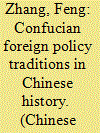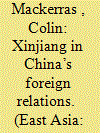| Srl | Item |
| 1 |
ID:
139159


|
|
|
|
|
| Summary/Abstract |
Can Confucianism enrich Chinese foreign policy? This article seeks to explore major traditions of Confucian foreign policy in imperial Chinese history and suggest their implications for contemporary Chinese foreign policy. The popular notion of Confucian pacifism is not a credible tradition of Confucian foreign policy, but a modern Chinese myth constructed in the early 20th century. Rather, Confucian foreign policy traditions were characterized by the contrasting ideas of inclusivism and exclusivism, neither of which renounced the use of force as a legitimate instrument of foreign policy. Both traditions were underpinned by a traditional Chinese theory of human nature. The adoption of inclusivism or exclusivism in foreign policy was a contingent outcome of relational interactions in China’s foreign relations. Confucianism’s inclusive humanism, reflected in the inclusive tradition, can provide a major intellectual inspiration for contemporary Chinese foreign policy. It can suggest a Confucian grand strategy of inclusive relationalism that significantly broadens the strategic vision of Chinese foreign policy. Chinese foreign policy discourse under President Xi Jinping already contains an important degree of inclusive relationalism. Putting this strategy more into practice will benefit both China and the world.
|
|
|
|
|
|
|
|
|
|
|
|
|
|
|
|
| 2 |
ID:
138963


|
|
|
|
|
| Summary/Abstract |
This paper analyses how the situation in China’s most northwestern province-level unit Xinjiang has affected China’s overall foreign relations since disturbances in its capital Ürümqi in July 2009. Xinjiang’s most populous ethnic group is the mostly-Muslim Uighurs. The paper assumes a framework that puts a high priority on China’s facing west. Though no more important than the eastward-looking foreign policy that has dominated Western analysis, the paper sees China’s facing west perspective as deserving more attention than it has received. Russia and Central Asian countries have been positive about China’s economic aims in the region. However, friction has increased with China’s rise, Chinese authorities tending to blame Xinjiang’s disturbances on Islamism in Central Asia. China resents the USA for giving asylum to Rebiya Kadeer, president of the anti-China World Uyghur Congress. In 2011, US Secretary of State Hillary Clinton pushed the idea of a “New Silk Road” in Central Asia for peaceful economic development. China has long espoused the “Silk Road” idea, developing its own “Silk Road Economic Belt.” Damaged due to the 2009 riots, the China-Turkey relationship has improved because of various visits and agreements since 2010. The paper balances the dominantly economic Silk Road concept against Islamist terrorism. It argues that the aims of the Silk Road and Silk Road Economic Belt are sensible and practical, with positive economic relations the main trend. However, although the Central Asian “zone of conflict” is a lesser trend, tensions are serious and long term, especially those caused by Islamism and Islamist terrorism.
|
|
|
|
|
|
|
|
|
|
|
|
|
|
|
|